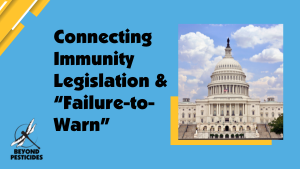08
Apr
Literature Review of Over 200 Studies Highlights Pesticide Threats to Womenâs Reproductive Health
(Beyond Pesticides, April 8, 2025) A comprehensive literature review in Environment & Health analyzes evidence from human biomonitoring, epidemiological studies, and toxicological studies that link adverse effects on womenâs reproductive health, specifically impacting the ovary, to pesticide exposure. In examining the scientific literature, consisting of over 200 studies performed in the last 25 years, the authors find pesticide exposure threatens womenâs health through ovarian dysfunction.
âEpidemiological studies have shown that pesticide exposures are associated with early/delayed menarche [first occurrence of menstruation], menstrual cycle disorders, early menopause, long time to pregnancy, polycystic ovary syndrome, primary ovarian insufficiency, infertility, and implantation failure in women,â the researchers state. They continue, âBoth in vivo [in animals] and in vitro [in cells] studies have shown that exposure to pesticides disrupts the estrous cycle, reduces the follicle pool, alters hormone levels, and impairs oocyte [egg] maturation.â
These reproductive implications are noted with many different classes of pesticides, such as insecticides, including organochlorine pesticides (OCPs), organophosphates (OPs), pyrethroids, and neonicotinoids, as well as herbicides and fungicides. The authors, however, comment on present research gaps: âMuch of the available epidemiological evidence focuses on legacy insecticides, such as OCPs, and a subset of insecticides that are still in use but in decline, such as OPs. Little research has been done on relatively newer insecticides whose use is increasing, such as neonicotinoids. Compared to insecticides, fewer studies have been conducted on herbicides and fungicides, although biomonitoring data show that these agrochemicals are also detected at relatively high rates in human biological samples.â
Despite the disproportionate amount of scientific literature available for all types of pesticides, the evidence shows common mechanisms of action of these different chemicals on ovarian function. The researchers report that these mechanisms include effects on steroid receptors, hormone synthesis, oxidative stress, inflammation, epigenetic modifications, and signaling pathways.
The ovaries, crucial for female reproduction, provide many functions that include producing eggs/oocytes and synthesizing steroid hormones such as estrogen and progesterone, which play a role in maintaining reproductive tissue, regulating ovarian function and ovulation, and establishing pregnancy. These vital functions are threatened by pesticide exposure, which as the researchers state, âcan interfere with steroid hormone synthesis by altering the activity and expression of key enzymes involved in steroidogenesis, leading to ovarian dysfunction.â
Numerous studies, as highlighted in the literature review, show that pesticide exposure âcan induce oxidative stress, inflammation and apoptosis [cell death] in ovarian cells, leading to DNA damage, altered gene expression and impaired ovarian function.â These studies cover various impacts on ovaries including abnormal estrous/menstrual cycles, reduced follicle numbers/diminished ovarian reserve, changes in hormone levels, disrupted oocyte maturation, decreased ovarian weight, reduced fertility, and increased risks of ovarian disorders such as polycystic ovary syndrome (PCOS) and premature ovarian insufficiency (POI). âAs many ovarian diseases are of unknown etiology, there is growing concern about the contribution of environmental factors to ovarian dysfunction,â the authors say. These studies provide evidence that pesticide exposure represents a large threat to womenâs reproductive health.
Insecticides
Organochlorine Pesticides (OCPs)
As previously reported by Beyond Pesticides, for the most part, organochlorine insecticides, including dichlorodiphenyltrichloroethane (DDT), are no longer used worldwide but the legacy of their poisoning and contamination persists. OCPs are primarily made up of chlorine atoms, classified as persistent organic pollutants due to their toxic longevity in the environment. Although many countries ban most organochlorine compounds, OCPs remain in the soil, water, and air at levels exceeding U.S. Environmental Protection Agency (EPA) standards.
Within the literature review, the researchers share the following relevant study results:
- A study in Spain shows âpeople living in areas of high pesticide use had a significantly higher risk of ovarian cancer and dysfunction.â
- âExposure to OCPs has been linked to the adverse effects on IVF outcomes, including pregnancy rate, number of oocytes retrieved, fertilization rate, embryo quality and live birth rate.â
- Pregnant mice exposed to DDT in a transgenerational study led to offspring with an increase in PCOS-like ovarian cysts.
- Lindane exposure in pregnant mice “resulted in a significant reduction in the number of germ cells in embryonic ovaries.â (See study here.)
Organophosphates (OPs)
In a previous Daily News, Beyond Pesticides shares that organophosphates are a family of insecticides derived from World War II nerve agents. They are cholinesterase inhibitors, meaning that they bind irreversibly to the active site of an essential enzyme for normal nerve impulse transmission, acetylcholinesterase (AChE), inactivating the enzyme. Due to this, OPs are often linked to neurological diseases and mental illness, but, as highlighted in the literature review, can also induce reproductive effects.
Studies note:
- Women with âcombined levels of DEP [diethylphosphate] and DETP [diethylthiophosphate] in urine samples were significantly associated with irregular menstrual cycles.â
- Higher urinary DETP levels are also âcorrelated with longer time to pregnancy and increased odds of infertility.â (See study here.)
- Diazinon âshowed greater oocyte toxicity, as this OP caused a reduced survival rate of mouse oocytes and inhibited the maturation of porcine (pig) oocytes at lower concentrations.â (See here and here.)
- Levels of diazinon and chlorpyrifos are ânegatively associated with the number of retrieved eggs and the implantation rate.â
- Rats exposed to chlorpyrifos show âreduced body weight, impaired ovarian redox homeostasis and decreased the serum levels of estradiol, progesterone and LH [luteinizing hormone].â (See studies here, here, and here.)
- In vitro studies of chlorpyrifos show inhibited oocyte maturation and fertilization.
- Acute malathion exposure in rats âdisrupted ovarian redox homeostasis, induced apoptosis and destroyed cell structure.â (See study here.)
- Malathion treatment in in vitro studies âhad adverse effects on the survival, quality and maturation rate of oocytes, and on in vitro fertilization and embryo development of fertilized oocytes.â (See here, here, and here.)
Pyrethroids
Pyrethroids, as documented by Beyond Pesticides, are evidenced to cause a myriad of health and environmental effects. (See additional coverage here.) As these insecticides are rapidly metabolized in the body, their metabolites (breakdown products) often serve as markers of pyrethroid exposure. The most commonly and frequently detected pyrethroid metabolite is 3-phenoxybenzoic acid (3-PBA).
Studies of pyrethroids, and their metabolites, within the review highlight reproductive effects including:
- âA case-control study showed that urinary concentrations of 3-PBA were positively associated with the risk of POI in Chinese women.â
- Rats exposed to fenvalerate exhibit âdecrease[s] in ovarian and body weights, and reduced numbers of preantral follicles and corpus luteum in adult female offspring.â (See study here.)
- Cypermethrin and lambda-cyhalothrin exposure in adult female “resulted in an abnormal estrus cycle, a decrease in ovarian weight, follicle and corpus luteum numbers, decreases in serum levels of estradiol, progesterone, FSH [follicle-stimulating hormone] and LH, and an increase in follicular atresia.â (See here, here, and here.)
- âOral exposure of rats to permethrin at doses of 20 mg/kg and 40 mg/kg disrupted ovarian follicular and subcellular structures with increased ovarian cell apoptosis.â
- âGestational exposure of mice to a mixture of eight commonly used pyrethroids at ADI [Acceptable Daily Intake] doses caused abnormal ovarian development and function, including a decrease in the number of primary follicles and estrogen levels, an increase in follicular atresia and FSH levels in adult female offspring.â
- â[I]n vitro treatment with cypermethrin or deltamethrin delayed maturation of fully grown oocytes, disrupted oocyte meiotic maturation, impaired oocyte mitochondrial functions, and induced oocyte apoptosis and autophagy [process that regulates cell death].â (See studies here and here.)
- Exposure to bifenthrin in rat cells can significantly inhibit the production of progesterone and other hormones. (See here and here.)
Neonicotinoids
While there is a wide body of science connecting neonicotinoids to impacts on pollinators, this is considered a relatively new class of insecticides that lacks extensive research on human health effects. The researchers note: âAlthough there are no epidemiological data on the relationship between neonicotinoid exposure and women ovarian health, experimental studies have shown the effects of neonicotinoids on mammalian ovaries. A few in vivo studies have demonstrated the ovarian toxicity of imidacloprid, the most extensively used neonicotinoid insecticide.â
They continue, âHuman exposure to neonicotinoids and their metabolites is mainly through diet intake and absorption, as residues of neonicotinoids and their metabolites have been frequently detected in food, surface water and drinking water, and indoor dust.â While studies involving human subjects are limited, research in mammals provides evidence of threats to womenâs health from these chemicals.
Evidence of reproductive effects from neonicotinoid exposure includes:
- Imidacloprid, in rat studies, decreased ovarian weight and altered hormone levels in mothers and their offspring, which shows transgenerational effects. (See studies here and here.)
- A study of imidacloprid exposure for 30 days in female rats also reveals clumping of oocytes.
- âThiamethoxam exposure reduced ovarian weight and decreased preovulatory follicles with increased atresia in female mice.â (See study here.)
- Chromosomal damage in cultured mammalian oocytes is noted with imidacloprid and acetamiprid.
Herbicides
While the majority of studies related to ovarian dysfunction focus on insecticide exposure, there are toxicological studies that report adverse effects of herbicides on mammalian ovarian development and function. (See Beyond Pesticidesâ coverage of herbicides here.) The research cited below on atrazine and glyphosate showcases the threats to reproduction from herbicides based on current scientific literature.
Atrazine
- âWomen in areas where atrazine was used extensively were more likely to report irregular and longer menstrual cycles than women in areas where atrazine was used sparingly.â (See study here.)
- âAnother study of 17 Chinese women who worked on the atrazine production line in a pesticide factory for 3 months showed that levels of urinary atrazine metabolites and serum estradiol were increased, while the length of the menstrual cycle and especially the ovulatory phase were shortened.â
- Rats exposed to atrazine have decreased levels of estradiol and progesterone, as well as increased testosterone levels.
- Additional studies in rats with atrazine exposure reveal oxidative stress, bleeding within the spaces between cells, and degenerative changes in the ovaries. (See here and here.)
Glyphosate
- Female mice exposed to glyphosate “caused decreased ovarian size or weight, increased ROS [Reactive Oxygen Species] levels, apoptosis and follicular atresia, decreased estradiol production with inhibited oocyte maturation.â (See here, here, here, and here.)
- â[G]lyphosate inhibits oocyte maturation, and increases oxidative stress, apoptosis and autophagy in oocytesâ.
- An in vitro study shows that glyphosate reduces hormone proliferation and production.
Fungicides
Fungicides are also underrepresented in scientific literature for reproductive impacts. âAlthough some studies have suggested that fungicide exposure may have deleterious effects on female reproduction, human data on associations between fungicide exposure and ovary-related outcomes remain scare,â the authors state. This broad class of pesticides is connected to various other acute and chronic health and environmental effects, as documented by Beyond Pesticides. Regarding implications of fungicide exposure to ovaries, the below studies note effects from mancozeb and vinclozolin exposure.
Mancozeb
- âToxicological evidence has shown that mancozeb, the most commonly used EBDC [ethylenebisdithiocarbamate], is an ovarian toxicant. Exposure of mice to mancozeb at doses of 500 mg/kg-800 mg/kg reduced litter size and ovarian weight, disrupted the estrous cycle with fewer healthy follicles and increased atresia.â (See studies here and here.)
- Increased ovarian cell death and fewer oocytes are observed in female mice after gestational and lactational exposure to mancozeb. (See here and here.)
Vinclozolin
- Female rats exposed to vinclozolin promoted the presence of ovarian cysts in their offspring (which resembles PCOS in women) and severely reduced primordial follicles (which resembles POI in women). The studies also note changes in DNA methylation, showing how these âepigenetic modifications appear to trigger changes in gene expression profiles, ultimately leading to dysregulation and an increased disease susceptibility in the affected offspring later in life.â (See here and here.)
- âBoth in vivo and in vitro exposure to vinclozolin delayed follicular progression and oocyte meiotic differentiation in fetal mouse ovaries.â
- Female rats exposed to vinclozolin for 14 days exhibited lower ovarian weight, irregular estrous cycles, and altered hormone levels. (See study here.)
The Need for an Organic Solution
These results highlight the reproductive threats that multiple classes of pesticides pose, which are often not included in regulatory risk assessments. (See more on regulatory deficiencies and EPA failures here.) These health implications, while needing to be studied further as the researchers note, can also be diminished with organic land management practices. By transitioning to a world that does not rely on petrochemical pesticides and synthetic fertilizers, as is Beyond Pesticidesâ mission, the health of all organisms (including humans and wildlife) is safeguarded while also protecting and enhancing the environment by mitigating the crises of biodiversity and climate change.
To learn more about human health and specific pesticides, visit the Pesticide-Induced Diseases Database and Gateway on Pesticide Hazards and Safe Pest Management. For least toxic control of pests in your home and garden, visit ManageSafe™ and make The Safer Choice. Interested in transitioning your community to organic? Sign up for the Parks for a Sustainable Future program as a Parks Advocate.
All unattributed positions and opinions in this piece are those of Beyond Pesticides.
Source:
Wang, L., Ma, X. and Liu, J. (2025) Adverse Effects of Pesticides on the Ovary: Evidence from Epidemiological and Toxicological Studies, Environment & Health. Available at: https://pubs.acs.org/doi/full/10.1021/envhealth.4c00243.










 State legislation to quash lawsuits against chemical manufacturers because of their âfailure to warnâ about the hazards of their pesticide products is moving forward in six state legislatures (
State legislation to quash lawsuits against chemical manufacturers because of their âfailure to warnâ about the hazards of their pesticide products is moving forward in six state legislatures ( Through grassroots efforts, coalitions and communities across the nation have successfully beat back this legislation in Mississippi, Wyoming, Montana, and Oklahoma this year after a successful defense in Missouri, Idaho, and Iowa in the 2024 legislative session. The publicâs voice is pivotal at this time!
Through grassroots efforts, coalitions and communities across the nation have successfully beat back this legislation in Mississippi, Wyoming, Montana, and Oklahoma this year after a successful defense in Missouri, Idaho, and Iowa in the 2024 legislative session. The publicâs voice is pivotal at this time! Dr. Gussow delivered a
Dr. Gussow delivered a 
